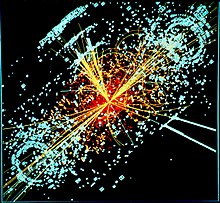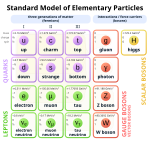Sudbury Neutrino Observatory

| Beyond the Standard Model |
|---|
 |
| Standard Model |
The Sudbury Neutrino Observatory (SNO) was a
The detector was turned on in May 1999, and was turned off on 28 November 2006. The SNO collaboration was active for several years after that analyzing the data taken.
The director of the experiment, Art McDonald, was co-awarded the Nobel Prize in Physics in 2015 for the experiment's contribution to the discovery of neutrino oscillation.[1]
The underground laboratory has been enlarged into a permanent facility and now operates multiple experiments as SNOLAB. The SNO equipment itself was being refurbished as of February 2017[update] for use in the SNO+ experiment.
Experimental motivation
The first measurements of the number of solar neutrinos reaching the Earth were taken in the 1960s, and all experiments prior to SNO observed a third to a half fewer neutrinos than were predicted by the
In 1984,
The Creighton Mine in Sudbury is among the deepest in the world and, accordingly, experiences a very small background flux of radiation. It was quickly identified as an ideal place for Chen's proposed experiment to be built,[3] and the mine management was willing to make the location available for only incremental costs.[5]: 440
The SNO collaboration held its first meeting in 1984. At the time it competed with
The experiment observed the light produced by
Detector description


The SNO detector target consisted of 1,000
The observatory is located at the end of a 1.5-kilometre-long (0.9 mi)
Charged current interaction
In the
Neutral current interaction
In the neutral current interaction, a neutrino dissociates the deuteron, breaking it into its constituent neutron and proton. The neutrino continues on with slightly less energy, and all three neutrino flavours are equally likely to participate in this interaction. Heavy water has a small cross section for neutrons, but when neutrons are captured by a deuterium nucleus, a gamma ray (photon) with roughly 6 MeV of energy is produced. The direction of the gamma ray is completely uncorrelated with the direction of the neutrino. Some of the neutrons produced from the dissociated deuterons make their way through the acrylic vessel into the light water jacket surrounding the heavy water, and since light water has a very large cross section for neutron capture, these neutrons are captured very quickly. Gamma rays of roughly 2.2 MeV are produced in this reaction, but because the energy of the photons is less than the detector's energy threshold (meaning they do not trigger the photomultipliers), they are not directly observable. However, when the gamma ray collides with an electron via Compton scattering, the accelerated electron can be detected through Cherenkov radiation.
Electron elastic scattering
In the
Experimental results and impact
The first scientific results of SNO were published on 18 June 2001,[8][9] and presented the first clear evidence that neutrinos oscillate (i.e. that they can transmute into one another), as they travel from the Sun. This oscillation, in turn, implies that neutrinos have non-zero masses. The total flux of all neutrino flavours measured by SNO agrees well with theoretical predictions. Further measurements carried out by SNO have since confirmed and improved the precision of the original result.
Although Super-K had beaten SNO to the punch, having published evidence for neutrino oscillation as early as 1998, the Super-K results were not conclusive and did not specifically deal with solar neutrinos. SNO's results were the first to directly demonstrate oscillations in solar neutrinos. This was important to the
Other possible analyses
The SNO detector would have been capable of detecting a
The SNO experiment was also able to observe atmospheric neutrinos produced by
Participating institutions
Large particle physics experiments require large collaborations. With approximately 100 collaborators, SNO was a rather small group compared to
Canada
- Carleton University
- Laurentian University
- Queen's University – designed and built many calibration sources and the device for deploying sources
- TRIUMF
- University of British Columbia
- University of Guelph
Although no longer a collaborating institution, Chalk River Laboratories led the construction of the acrylic vessel that holds the heavy water, and Atomic Energy of Canada Limited was the source of the heavy water.
United Kingdom
- University of Oxford – developed much of the experiment's Monte Carlo analysis program (SNOMAN), and maintained the program
- University of Sussex – calibration
United States
- Lawrence Berkeley National Laboratory (LBNL) – Led the construction of the geodesic structure that holds the PMTs
- Pacific Northwest National Laboratory (PNNL)
- Los Alamos National Laboratory (LANL)
- University of Pennsylvania – designed and built the front end electronics and trigger
- University of Washington – designed and built proportional counter tubes for detection of neutrons in the third phase of the experiment
- Brookhaven National Laboratory
- University of Texas at Austin
- Massachusetts Institute of Technology
Honours and awards
- 14724 SNOis named in honour of SNO.
- In November 2006, the entire SNO team was awarded the inaugural John C. Polanyi Award for "a recent outstanding advance in any field of the natural sciences or engineering" conducted in Canada.[12]
- SNO principal investigator Arthur B. McDonald won the 2015 Nobel Prize in Physics, jointly with Takaaki Kajita of Super-Kamiokande, for the discovery of neutrino oscillation.
- SNO was awarded the 2016 Fundamental Physics Prizealong with 4 other neutrino experiments.
See also
- DEAP – Dark Matter Experiment using Argon Pulse-shape at SNO location
- Homestake experiment – A predecessor experiment conducted 1970–1994 in a mine at Lead, South Dakota
- SNO+ – The successor of SNO
- SNOLAB – A permanent underground physics laboratory being built around SNO
References
46°28′30″N 81°12′04″W / 46.47500°N 81.20111°W[13]
- ^ "2015 Nobel Prize in Physics: Canadian Arthur B. McDonald shares win with Japan's Takaaki Kajita". CBC News. 2015-10-06.
- PMID 10031848.
- ^ a b c "The Sudbury Neutrino Observatory – Canada's eye on the universe". CERN Courier. CERN. 4 December 2001. Retrieved 2008-06-04.
- ^ "Heavy Water". 31 January 2006. Archived from the original on 2015-12-19. Retrieved 2015-12-03.
- . A good retrospective on the project.
- ^ Brewer, Robert. "Deep Sphere: The unique structural design of the Sudbury Neutrinos Observatory buried within the earth". Canadian Consulting Engineer. Archived from the original on 2016-03-04. Retrieved 2016-01-14.
- ^ "Black hole to trap neutrinos completed by Inco miners" (PDF). Inco Triangle. 52 (5): 1. May 1993.
- ^
Ahmad, QR; et al. (2001). "Measurement of the Rate of νe + d → p + p + e− Interactions Produced by 8B Solar Neutrinos at the Sudbury Neutrino Observatory". PMID 11497878.
- ^ "Sudbury Neutrino Observatory First Scientific Results". 3 July 2001. Archived from the original on 2015-12-12. Retrieved 2008-06-04.
- ^ "Arthur B. McDonald, Ph.D". Franklin Laureate Database. Franklin Institute. Archived from the original on 2008-10-04. Retrieved 2008-06-04.
- ^ "The Nobel Prize in Physics 2015". Retrieved 2015-10-06.
- ^ "Past Winners – The Sudbury Neutrino Observatory". NSERC. 3 March 2008. Retrieved 2008-06-04.
- ^ SNOLAB User's Handbook Rev. 2 (PDF), 2006-06-26, p. 33, retrieved 2013-02-01
External links
 Media related to Sudbury Neutrino Observatory at Wikimedia Commons
Media related to Sudbury Neutrino Observatory at Wikimedia Commons- SNO's official site
- Joshua Klein's Introduction to SNO, Solar Neutrinos, and Penn at SNO
- "Experiment Cave". PBS.
- Written and Directed by David Sington (2006-02-21). "The Ghost Particle". PBS.
- Showcase of Canadian Engineering Achievement: Sudbury Neutrino Observatory (IEEE Canada). Several articles about the civil engineering of SNO.
- SNO experiment record on INSPIRE-HEP

